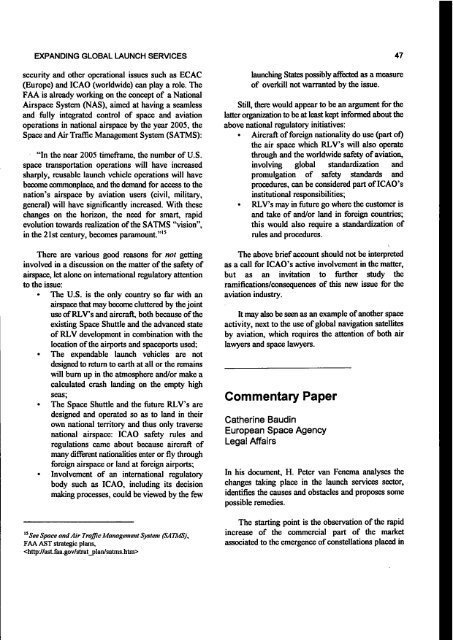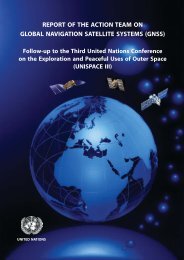46 EXPANDING GLOBAL LAUNCH SERVICESinternational launch cooperation, is stronglydiscouraged, irrespective <strong>of</strong> <strong>the</strong> peaceful character <strong>of</strong><strong>the</strong> project, is one that, in <strong>the</strong> interest <strong>of</strong> <strong>the</strong> samecustomers, deserves to be challenged within <strong>the</strong> MTCRgroup <strong>of</strong> countries, but not only <strong>the</strong>re.The question does becomes one <strong>of</strong> finding <strong>the</strong> right<strong>for</strong>um <strong>for</strong> discussing this apparent incompatibility <strong>of</strong>national security and international trade, in <strong>the</strong> light <strong>of</strong>its short and long term effects on <strong>the</strong> growth andsophistication <strong>of</strong> <strong>the</strong> international launch industry andon <strong>the</strong> well-being <strong>of</strong> <strong>the</strong> global customers who dependon <strong>the</strong> <strong>for</strong>mer’s services.Undoubtedly <strong>the</strong> WTO GATS discussions, whichresume in November 1999 in Seattle, provide a <strong>for</strong>um<strong>for</strong> discussing <strong>the</strong> trade-related aspects <strong>of</strong> <strong>the</strong> issue(which discussion may, <strong>of</strong> course, get uncom<strong>for</strong>tablyclose to a door saying “national security: notrespassing”!).Could UNCOPUOS play a role?Not, it is submitted, as a (de-) regulator <strong>of</strong> launchservices, nor as a judge <strong>of</strong> what is a real nationalsecurity concern and what is not. Two o<strong>the</strong>r aspects <strong>of</strong>UNCOPUOS’ work justify die Committee’s possibleinvolvement in <strong>the</strong> discussion:First, <strong>the</strong> Committee, inter alia through itsScientific and Technical Subcommittee, has anunparallelled experience in promoting internationalcooperation in <strong>the</strong> peaceful uses <strong>of</strong> outer space, and is<strong>the</strong>re<strong>for</strong>e well-positioned to contribute to a review <strong>of</strong> <strong>the</strong>advisability and feasibility <strong>of</strong> international projectsinvolving launch cooperation.Second, <strong>the</strong> Committee, inter alia through its LegalSubcommittee, is not only draftsman and guardian <strong>of</strong>a series <strong>of</strong> space treaties and o<strong>the</strong>r instruments dealingwith <strong>the</strong> legal aspects <strong>of</strong> space activities, it is also aboutto engage in an analysis <strong>of</strong> whe<strong>the</strong>r, and if so, to whatextent, this body <strong>of</strong> space law and policy is stilladequate in regulating <strong>the</strong> space activities <strong>of</strong> States ando<strong>the</strong>r entities governed by <strong>the</strong> respective rules,particularly in <strong>the</strong> light <strong>of</strong> <strong>the</strong> explosive growth <strong>of</strong>private commercial space activities.In that connection, it would make practical sense torefrain from an approach, which has enthusiastic spacelawyers (like <strong>the</strong> author <strong>of</strong> this report) looking <strong>for</strong> gapsin <strong>the</strong> various treaties, and, instead, start a dialogueinvolving in particular <strong>the</strong> industries and organizationsengaged in private, commercial space activities, with<strong>the</strong> purpose <strong>of</strong> reviewing and analyzing <strong>the</strong> way inwhich <strong>the</strong> present regulatory regime affects <strong>the</strong>ir presentand future operations.In that dialogue, it would be entirely appropriate toalso include <strong>for</strong> review o<strong>the</strong>r regulatory instruments,such as <strong>the</strong> ones treated above, which influence <strong>the</strong>development <strong>of</strong> <strong>the</strong> trade in launch services.It should be emphasized that this exercise is notmeant to create new standards or new instruments, butra<strong>the</strong>r to discuss - without losing sight <strong>of</strong> what <strong>the</strong>treaties and o<strong>the</strong>r applicable instruments tried toaccomplish - from a practical angle, <strong>the</strong> requirements <strong>of</strong>modern-style exploration and use <strong>of</strong> outer space, bothtoday’s and tomorrow’s.Concluding remarksIn <strong>the</strong> <strong>for</strong>egoing, many aspects <strong>of</strong> launching as a spaceactivity have not been discussed, notwithstanding <strong>the</strong>irimportance <strong>for</strong> <strong>the</strong> customers, <strong>the</strong> regulators and o<strong>the</strong>rparties concerned. Time, space and <strong>the</strong> perceivedpatience <strong>of</strong> <strong>the</strong> readers were limiting factors.Never<strong>the</strong>less, <strong>the</strong>re is one issue that deserves to bebriefly mentioned at this stage, namely that <strong>of</strong> <strong>the</strong> safety<strong>of</strong> launching/space transportation, on <strong>the</strong> ground(spaceports), in airspace and in outer space.With <strong>the</strong> increase <strong>of</strong> launch activities, caused by <strong>the</strong>increased use <strong>of</strong> <strong>the</strong> low-earth orbit <strong>for</strong> LEO satellitecommunications conglomerates, <strong>the</strong> joint use <strong>of</strong> airspace by aircraft and launch vehicles may become amatter <strong>of</strong> safety-related concerns, particularly with <strong>the</strong>advent <strong>of</strong> re-usable launch vehicles (RLV’s), now underconstruction in <strong>the</strong> U.S. and <strong>the</strong> increasing use <strong>of</strong> airlaunchedvehicles such as <strong>the</strong> Pegasus. This may be anissue where <strong>the</strong> experience <strong>of</strong> both national licensingagencies (FAA) and regional institutions (JAA),Eurocontrol, as well as IGO’s, dealing with safety,
EXPANDING GLOBAL LAUNCH SERVICES 47security and o<strong>the</strong>r operational issues such as ECAC(Europe) and ICAO (worldwide) can play a role. TheFAA is already working on <strong>the</strong> concept <strong>of</strong> a NationalAirspace System (NAS), aimed at having a seamlessand fully integrated control <strong>of</strong> space and aviationoperations in national airspace by <strong>the</strong> year 2005, <strong>the</strong>Space and Air Traffic Management System (SATMS):“In <strong>the</strong> near 2005 timeframe, <strong>the</strong> number <strong>of</strong> U.S.space transportation operations will have increasedsharply, reusable launch vehicle operations will havebecome commonplace, and <strong>the</strong> demand <strong>for</strong> access to <strong>the</strong>nation’s airspace by aviation users (civil, military,general) will have significantly increased. With <strong>the</strong>sechanges on <strong>the</strong> horizon, <strong>the</strong> need <strong>for</strong> smart, rapidevolution towards realization <strong>of</strong> <strong>the</strong> SATMS “vision”,in <strong>the</strong> 21st century, becomes paramount.”15There are various good reasons <strong>for</strong> not gettinginvolved in a discussion on <strong>the</strong> matter <strong>of</strong> <strong>the</strong> safety <strong>of</strong>airspace, let alone on international regulatory attentionto <strong>the</strong> issue:The U.S. is <strong>the</strong> only country so far with anairspace that may become cluttered by <strong>the</strong> jointuse <strong>of</strong> RLV’s and aircraft, both because <strong>of</strong> <strong>the</strong>existing Space Shuttle and <strong>the</strong> advanced state<strong>of</strong> RLV development in combination with <strong>the</strong>location <strong>of</strong> <strong>the</strong> airports and spaceports used;• The expendable launch vehicles are notdesigned to return to earth at all or <strong>the</strong> remainswill bum up in <strong>the</strong> atmosphere and/or make acalculated crash landing on <strong>the</strong> empty highseas;• The Space Shuttle and <strong>the</strong> future RLV’s aredesigned and operated so as to land in <strong>the</strong>irown national territory and thus only traversenational airspace: ICAO safety rules andregulations came about because aircraft <strong>of</strong>many different nationalities enter or fly through<strong>for</strong>eign airspace or land at <strong>for</strong>eign airports;• Involvement <strong>of</strong> an international regulatorybody such as ICAO, including its decisionmaking processes, could be viewed by <strong>the</strong> few15 See Space and Air Traffic Management System (SA TMS),FAA AST strategic plans,launching States possibly affected as a measure<strong>of</strong> overkill not warranted by <strong>the</strong> issue.Still, <strong>the</strong>re would appear to be an argument <strong>for</strong> <strong>the</strong>latter organization to be at least kept in<strong>for</strong>med about <strong>the</strong>above national regulatory initiatives:• Aircraft <strong>of</strong> <strong>for</strong>eign nationality do use (part <strong>of</strong>)<strong>the</strong> air space which RLV’s will also operatethrough and <strong>the</strong> worldwide safety <strong>of</strong> aviation,involving global standardization andpromulgation <strong>of</strong> safety standards andprocedures, can be considered part <strong>of</strong> ICAO’sinstitutional responsibilities;• RLV’s may in future go where <strong>the</strong> customer isand take <strong>of</strong> and/or land in <strong>for</strong>eign countries;this would also require a standardization <strong>of</strong>rules and procedures.The above brief account should not be interpretedas a call <strong>for</strong> ICAO’s active involvement in <strong>the</strong> matter,but as an invitation to fur<strong>the</strong>r study <strong>the</strong>ramifications/consequences <strong>of</strong> this new issue <strong>for</strong> <strong>the</strong>aviation industry.It may also be seen as an example <strong>of</strong> ano<strong>the</strong>r spaceactivity, next to <strong>the</strong> use <strong>of</strong> global navigation satellitesby aviation, which requires <strong>the</strong> attention <strong>of</strong> both airlawyers and space lawyers.Commentary PaperCa<strong>the</strong>rine BaudinEuropean Space AgencyLegal AffairsIn his document, H. Peter van Fenema analyses <strong>the</strong>changes taking place in <strong>the</strong> launch services sector,identifies <strong>the</strong> causes and obstacles and proposes somepossible remedies.The starting point is <strong>the</strong> observation <strong>of</strong> <strong>the</strong> rapidincrease <strong>of</strong> <strong>the</strong> commercial part <strong>of</strong> <strong>the</strong> marketassociated to <strong>the</strong> emergence <strong>of</strong> constellations placed in
















